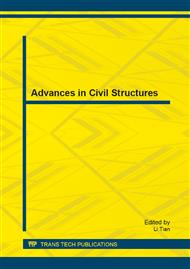p.771
p.775
p.782
p.786
p.790
p.798
p.803
p.808
p.812
Research on Behavior of Rectangular CFST Stub Columns with Binding Bars under Axial Compression
Abstract:
The constitutive model of core concrete was proposed, which was suitable for finite element (FE) analysis of rectangular concrete-filled steel tubular (CFST) columns with binding bars. Based on the ABAQUS FE platform, the USDFLD subroutine was compiled, which could consider the changing of Poisson ratio of many materials in loading process. A FE model was developed and used to simulate the rectangular CFST columns with binding bars. The mechanical behavior were analyzed for stress versus strain relationship curves, confined effect among steel tube, core concrete and binding bars, longitudinal stress distributions of core concrete. The results show that the FE results simulated by using constitutive relationship of core concrete of this paper are in good agreement with test results. The local buckling of steel tube is delayed which can make the yield of steel tube occur before ultimate strength of specimens, the concrete confinement of the corner regions and central regions is improved, the longitudinal stress of concrete is increased and the capacity and ductility of specimens are improved, by setting binding bars and decreasing the binding bars spacing.
Info:
Periodical:
Pages:
790-797
Citation:
Online since:
August 2013
Authors:
Keywords:
Price:
Сopyright:
© 2013 Trans Tech Publications Ltd. All Rights Reserved
Share:
Citation:


